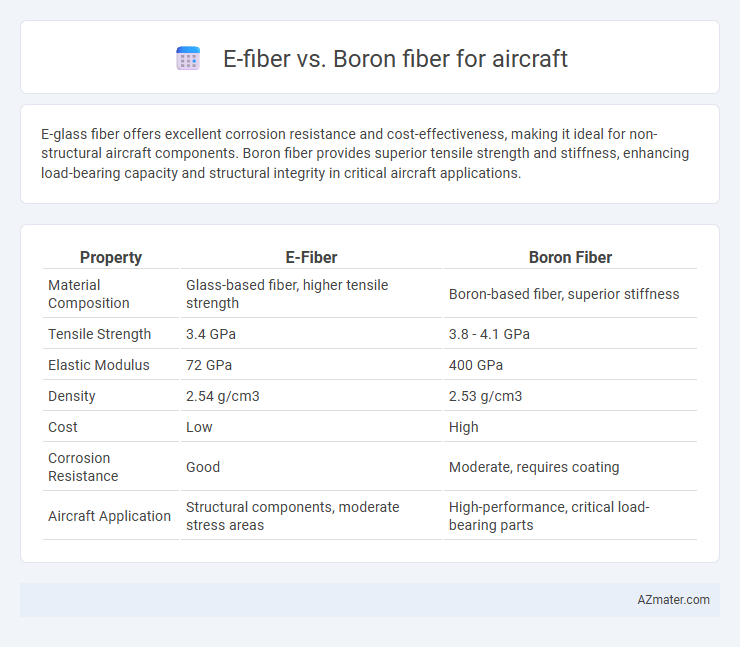E-glass fiber offers excellent corrosion resistance and cost-effectiveness, making it ideal for non-structural aircraft components. Boron fiber provides superior tensile strength and stiffness, enhancing load-bearing capacity and structural integrity in critical aircraft applications.
Table of Comparison
| Property | E-Fiber | Boron Fiber |
|---|---|---|
| Material Composition | Glass-based fiber, higher tensile strength | Boron-based fiber, superior stiffness |
| Tensile Strength | 3.4 GPa | 3.8 - 4.1 GPa |
| Elastic Modulus | 72 GPa | 400 GPa |
| Density | 2.54 g/cm3 | 2.53 g/cm3 |
| Cost | Low | High |
| Corrosion Resistance | Good | Moderate, requires coating |
| Aircraft Application | Structural components, moderate stress areas | High-performance, critical load-bearing parts |
Introduction to Advanced Composite Fibers in Aviation
E-fiber and Boron fiber are critical advanced composite materials in aviation, with E-fiber known for its high tensile strength, lightweight properties, and electrical insulation capabilities, making it ideal for fuselage and wing structures. Boron fiber offers exceptional stiffness and compressive strength, enabling enhanced load-bearing performance and durability in critical aircraft components such as landing gears and control surfaces. These fibers significantly improve aircraft performance by reducing weight, enhancing fuel efficiency, and increasing structural integrity compared to traditional materials.
E-Fiber and Boron Fiber: Material Overview
E-fiber, known for its excellent electrical insulation and high tensile strength, is a type of glass fiber widely used in aircraft composites due to its lightweight properties and cost-effectiveness. Boron fiber offers superior stiffness, high tensile modulus, and exceptional strength-to-weight ratio, making it ideal for structural components requiring high performance and resistance to fatigue. Both materials are integral in aerospace applications, with E-fiber favored for electrical insulation and impact resistance, while Boron fiber is preferred for enhancing load-bearing capabilities and rigidity.
Mechanical Properties: Strength, Stiffness, and Weight
E-fiber composites exhibit high tensile strength and moderate stiffness, making them suitable for lightweight aircraft structures that require flexibility and damage tolerance. Boron fiber offers exceptional stiffness and superior compressive strength, significantly enhancing the load-bearing capacity of critical aircraft components while maintaining low weight. The combination of boron fiber's high modulus and E-fiber's toughness results in optimized mechanical performance for aerospace applications demanding both strength and weight efficiency.
Comparative Fatigue Resistance
E-fiber composites demonstrate superior fatigue resistance compared to Boron fiber in aircraft applications, maintaining structural integrity under cyclic loading conditions over extended flight cycles. Boron fiber, while offering higher stiffness and strength, tends to exhibit reduced fatigue life due to microcrack initiation and propagation under repetitive stress. Engineers often prefer E-fiber for components subjected to continuous dynamic stress where long-term durability and fatigue performance are critical.
Thermal Stability and Performance
E-fiber composites exhibit moderate thermal stability with degradation temperatures around 400degC, making them suitable for general aerospace applications where cost-effectiveness and lightweight properties are prioritized. Boron fibers offer superior thermal stability, maintaining mechanical performance beyond 1000degC, which enhances resistance to thermal degradation and ensures structural integrity in high-temperature aircraft environments. The exceptional thermal performance of Boron fibers results in higher stiffness-to-weight ratios and improved durability under extreme thermal cycles compared to E-fibers, making them ideal for critical aircraft components exposed to elevated temperatures.
Corrosion and Environmental Durability
E-fiber exhibits superior corrosion resistance in aircraft applications compared to Boron fiber, which is prone to corrosion in humid and saline environments, compromising structural integrity. Environmental durability of E-fiber is enhanced by its resistance to moisture absorption and chemical degradation, ensuring longer service life under varied atmospheric conditions. Boron fiber's susceptibility to galvanic corrosion when interfaced with aluminum alloys requires protective coatings, increasing maintenance complexity and weight in aircraft structures.
Manufacturing Processes and Cost Implications
E-fiber composites offer streamlined manufacturing processes due to their compatibility with conventional wet layup and infusion techniques, reducing labor and equipment costs in aircraft production. Boron fiber requires specialized handling and curing methods, such as autoclave processing, leading to higher manufacturing complexity and expenses. The cost implications favor E-fiber in large-scale aircraft applications, balancing performance with economic feasibility.
Applications in Aircraft Structures
E-fiber composites excel in aircraft structural applications requiring high strength-to-weight ratios, such as fuselage panels and wing skins, due to their excellent electrical insulation and corrosion resistance. Boron fiber is favored for critical reinforcement areas like landing gear components and engine mounts because of its superior stiffness and tensile strength. The integration of E-fiber in non-load bearing structures and boron fiber in load-bearing elements optimizes overall aircraft performance by balancing durability, weight, and cost.
Recent Innovations and Research Developments
Recent innovations in aircraft materials highlight significant advances in both E-fiber and boron fiber composites, with E-fiber gaining enhanced toughness and fatigue resistance through nano-engineering techniques. Boron fiber research has progressed toward improving its corrosion resistance and damage tolerance using advanced coatings and hybrid composite matrices. These developments emphasize weight reduction and improved mechanical performance critical for next-generation aerospace applications.
Summary: Choosing the Right Fiber for Aircraft Design
E-fiber offers superior electrical conductivity and electromagnetic interference (EMI) shielding, making it ideal for aircraft requiring advanced avionics protection, while Boron fiber excels in high stiffness and strength-to-weight ratio, crucial for structural components. Selecting the right fiber hinges on balancing performance requirements such as mechanical strength, weight reduction, and electrical properties specific to the aircraft's mission profile. Integrating hybrid composites that combine both E-fiber and Boron fiber can optimize overall aircraft performance by leveraging the distinct advantages of each material.

Infographic: E-fiber vs Boron fiber for Aircraft
 azmater.com
azmater.com